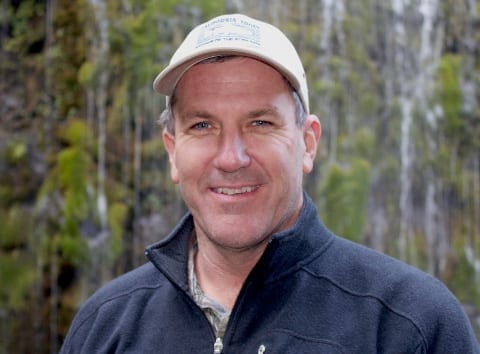A CalTrout Interview: North Coast Regional Manager Darren Mierau
Editor’s Note: CalTrout’s Regional Managers are at the heart of CalTrout’s accomplishments; they make the calls, visit the sites, attend the meetings, protect the rivers, negotiate when they can, fight when they can’t, and generally show up for work wearing a big red “S.”
We think it’s time you met them.
Accordingly, enjoy the first in a series of interviews with our Regional Managers.
Meet Darren Mierau
Tell us a little about yourself and your region.
I’m Darren Mierau and I manage California Trout’s North Coast region, which stretches roughly from the Russian River north to the Smith River. I’d say the heart of the region revolves around the Smith River, Redwood Creek, the Trinity River and the Eel River.

CalTrout North Coast Manager Darren Mierau.
There are some truly amazing rivers on the Mendocino coast, but I’m focused on the rivers like the Trinity and Eel where CalTrout’s biggest opportunities lie. They hold a lot of potential for recovering salmon and steelhead populations.
I can say this: I work in a beautiful part of the world.
What are the critical issues facing the North Coast region?
Two issues that consume much of my time are the Trinity River restoration and our work on the Eel River, which is really picking up momentum.
The Trinity River is a story that many are familiar with; starting in the early 1960s, up to 90% of the Trinity’s flows were diverted south, and it took 38 years to get even some of that water back.
Now we’re in the midst of one of the largest steelhead and salmon restoration program in the State, and while that’s generally moving along, some stakeholders — including me — have concerns that the Program is veering away from how it was originally envisioned.
The Eel River is occupying a lot of my attention. CalTrout’s leading the development of the Eel River Task Force, a recognition of the fact the Eel is a huge watershed with some issues that are too complex for any one agency or organization to address. We have to work together to make critical decisions about how to allocate limited resources to achieve the most progress toward species recovery and protection.
I’m working with stakeholders on several projects: the Eel River Estuary Preserve project, the Bridge Creek railroad crossing removal, Woodman Creek Fish Passage Project, and eventually PG&E’s Potter Valley Project to name a few.
Some projects — the Bridge Creek barrier removal — will have an immediate impact by opening up more habitat.
Other projects — like the Estuary Preserve — are more of a blank slate. The results could be spectacular, but a lot needs to be done.
The Eel has enormous potential — it drains about 3,684 square miles — yet it has suffered so much from poor logging practices and the floods of the 50s and 60s, from which it’s never really recovered. Today’s Chinook, steelhead and coho runs are in the 1% to 10% range of historic numbers.
I’m really looking forward to seeing it come back to life.
What are the long-term issues facing the north coast region?
Many of the projects I’m working on today will be the same projects I’m working on a few years from now. Some — like the Bridge Creek and Woodman Creek railroad crossing removal — will go quickly, but restoring the Eel River and Trinity River are long-term prospects.
Tell us about your favorite place in your region – where you’d send visitors to the area.
The South Fork Smith River is as beautiful as any place in the state, and the steelhead fishing can be good. The Mattole is also beautiful, and its steelhead fishery is coming back.
The whole Mendocino Coast is awesome. I hope to expand my program out there in the near future.





1 Comment
Am very disappointed that Darren Mierau has not included the Smith River as one of his North Coast priorities. In past years the Smith has received a lot of attention from CalTrout, but that seems to have changed since Darren has come on board. Granted, the Smith may still be a healthy river, and a salmon stroghold, but that does not mean it should be ignored — it is far less expensive to protect a river that is still healthy than to bring one back once it has gone down the tubes. BRT